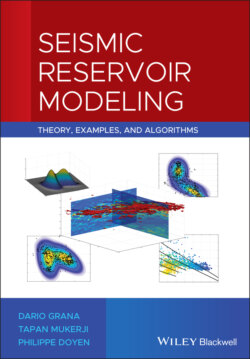Читать книгу Seismic Reservoir Modeling - Dario Grana - Страница 23
1.4.3 Gaussian Distribution
ОглавлениеMost of the random variables of interest in reservoir modeling are continuous. The most common PDF for continuous variables is the Gaussian distribution, commonly called normal distribution. We say that a random variable X is distributed according to a Gaussian distribution with mean μX and variance , if its PDF fX(x) can be written as:
(1.33)
A Gaussian distribution with 0 mean and variance equal to 1 is also called standard Gaussian distribution (or normal distribution). The Gaussian distribution is symmetric and unimodal (Figure 1.8) and can be used to describe a number of phenomena in nature. The Gaussian distribution is defined on the entire set ℝ of real numbers and it is always positive. For example, the standard Gaussian distribution in Figure 1.8 is always greater than 0, but the probability of the random variable being greater than 3 or less than 3 is close to 0, hence negligible.
Figure 1.7 Uniform probability density function in the interval [1, 3].
Figure 1.8 Standard Gaussian probability density function with 0 mean and variance equal to 1.
As shown in Eq. (1.15), in order to compute any probability associated with the random variable X, we must compute an integral. For a Gaussian distribution, the integral of Eq. (1.33) has no analytical form; therefore, we must use numerical tables of the cumulative density function of the standard Gaussian distribution (Papoulis and Pillai 2002). For example, if X is a random variable distributed according to a standard Gaussian distribution , then we can compute the following probabilities P(X ≤ 1) ≅ 0.84, P(X ≤ 1.5) ≅ 0.932, P(X ≤ 2) ≅ 0.977, using the numerical tables. Similarly, we obtain that P(−1 ≤ X ≤ 1) ≅ 0.68, P(−2 ≤ X ≤ 2) ≅ 0.954, and P(−3 ≤ X ≤ 3) ≅ 0.997.
To compute a probability associated with a non‐standard Gaussian distribution with mean μY and variance , we apply the transformation X = (Y − μY)/σY and we use the numerical tables of the standard Gaussian distribution. Indeed, the random variable X is a standard Gaussian distribution with 0 mean and variance equal to 1, and For example, if Y has a Gaussian distribution with mean μY = 1 and variance , then we define a new random variable X = (Y − 1)/2. The probability P(Y ≤ 2) is then equal to the probability P(X ≤ 0.5) ≅ 0.69. Similarly, P(−3 ≤ Y ≤ 3) = P(−2 ≤ X ≤ 1) ≅ 0.82.
In general, the probability that a Gaussian random variable X takes values in the interval (μX − σX, μX + σX) is approximately 0.68; in the interval (μX − 2σX, μX + 2σX) is approximately 0.95; and in the interval (μX − 3σX, μX + 3σX) is approximately 0.99. Therefore, there is a high probability that the values of the Gaussian random variable are in the interval of length 6σX centered around the mean μX, even though the tails of the distributions have non‐zero probability for values greater than μX + 3σX or less than μX − 3σX.
Because a Gaussian PDF takes positive values in the entire real domain, when using Gaussian distributions for bounded random variables, such as volumetric fractions, or positive random variables, such as velocities, one should truncate the distribution to avoid non‐physical outcomes or apply a suitable transformation (Papoulis and Pillai 2002), such as the normal score or logit transformations of the original variables.
